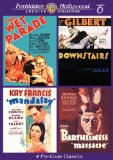| Reviews & Columns |
|
Reviews DVD TV on DVD Blu-ray 4K UHD International DVDs In Theaters Reviews by Studio Video Games Features Collector Series DVDs Easter Egg Database Interviews DVD Talk Radio Feature Articles Columns Anime Talk DVD Savant Horror DVDs The M.O.D. Squad Art House HD Talk Silent DVD
|
DVD Talk Forum |
|
|
| Resources |
|
DVD Price Search Customer Service #'s RCE Info Links |
|
Columns
|
|
|
Forbidden Hollywood Collection: Volume 6
Nudity, premarital sex, violent crime, prostitution ... Hollywood could get away with most anything during the Pre-Code period. It's all in Warner Archives' recent m.o.d. collection, Forbidden Hollywood, Vol. 6.
A short history lesson: although the Hayes Code was established in 1930 as an agreed-upon set of guidelines between censorship boards and the Hollywood studios, at the time it was only loosely adhered to (after all, sex and violence sold tickets). It wasn't until the summer of 1934, when the Breen Office established a mandatory Production Code which stayed in place for more than thirty years. It is this pre-sanitized period that is celebrated in Warner Bros.' wonderful Forbidden Hollywood DVD series, currently at its seventh volume. As with all of volumes since last year's #4, the four-disc Forbidden Hollywood, Volume 6 reviewed here is available through the Warner Archive made-on-demand (m.o.d.) DVD reissues of undiscovered television and film from the bottomless Warner-owned vaults.
At first glance, the films selected for Forbidden Hollywood, Volume 6 appear to be a randomly selected bunch. The four films are all polished dramas released by MGM or Warner/First National in 1932-34, however, and to a certain extent each one deals with risk-taking material. While 1932's The Wet Parade takes a hard-hitting look at alcohol abuse, the 1934 production Massacre goes out of its way to portray Native Americans in a modern, non-stereotypical light. Washed-up silent idol John Gilbert defies expectations and helps transform the soapy histrionics of Downstairs into a penetrating drama that addresses social mores in a surprisingly astute way. Finally, the tropical corker Mandalay is what resulted when Warner Bros. employed the studio's most accomplished craftsmen in support of the period's most unique leading lady, Kay Francis.
The Wet Parade (1932; 118 minutes)
The turgid yet fascinating melodrama The Wet Parade was MGM's well-intentioned attempt to address the scourge of alcohol. Directed by Victor Fleming (Gone with the Wind) and adapted from Upton Sinclair's pro-Temperance novel, the film chronicles the shifting fortunes of two American families in the 1910s and into the '20s as Prohibition takes hold, right up to the present day. It begins with a peek into a traditional Southern family, the Chilcotes, with Lewis Stone as the patriarch in a wealthy household with two adult children, played by Dorothy Jordan and Neil Hamilton. While the sweet Maggie (Jordan) attempts to keep her father away from the demon whiskey that's killing him, her nonconfomist writer sibling Roger (Hamilton) moves north to a New York boarding house run by the second family in our tale, the Tarletons. Like the Chilcotes, this family sports a soused dad, a pompous politico played by Walter Huston. The boarding house is run by the harried wife of Huston's character, Clara Blandick, and their upstanding son, Kip (Robert Young). Meanwhile, after the elder Chilcote succumbs to the twin temptations of booze and gambling, Maggie arrives at the boarding house to check in on her brother. After all this familial exposition (still paying attention?), the film becomes a flurry of true-life history as World War I erupts, Congress responds with the Food Control Act, the Roaring '20s storm in, and Hamilton's Roger gets smitten by a sexy society dame with political connections (Myrna Loy in her slinky phase). Don't forget a relatively sedate performance from Jimmy Durante, cast as federal agent in hot pursuit of bootleggers.
Although MGM pulled out all the stops for The Wet Parade, the end result winds up being something of a ponderous (but watchable) mess. It retains some fascination for the Prohibition/alcohol angle, and yet the film never adequately settles on one side or the other in the debate, a still contentious subject back in 1932. At least director Victor Fleming wrests some good performances out of his cast, highlighted by Robert Young (in his fifth film), Lewis Stone, and the always-great Walter Huston (the obscure Dorothy Jordan seems out of her depth, however). The heavy emoting in Sinclair's novel weighed this production down, however, which ultimately sags the film under its punishing, nearly two-hour length. The resulting human drama winds up being overly played out, and ultimately not satisfying. Not surprisingly, the best moment in The Wet Parade occurs with an utterly engrossing, dialogue-free montage depicting the bottling and packaging of bootlegged liquor, a sequence which must have delighted the producers of Boardwalk Empire.
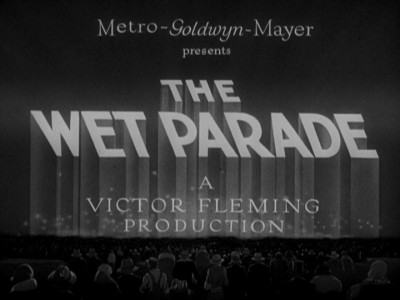
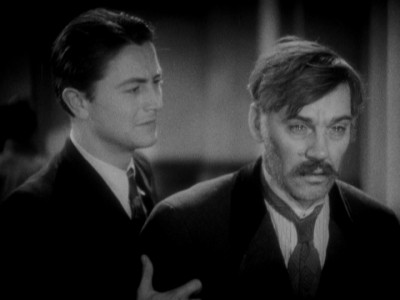
Downstairs (1932; 77 minutes)
The soapy MGM production Downstairs follows the trials of a wealthy European couple and their servants in a torrid, proto-Downton Abbey setting. The film supplies one of the better talking vehicles for the fading silent star John Gilbert, who in addition to starring also wrote the story Downstairs is based on. The opening finds Gilbert's Karl Schneider, a caddish chauffeur, worming his way back into the employ of the wealthy Von Burgens, who are hosting a lavish wedding for two of their household staffers, head butler Albert (Paul Lukas) and maid Anna (Virginia Bruce). Karl, an opportunistic slime who previously had an affair with a married Countess (Hedda Hopper, pre-gossip column), immediately zeroes in on the lovely Anna as his next would-be conquest. Although resistant at first, Anna starts to warm to Karl when Albert accepts him into their social circle in their off hours. Meanwhile, Karl is stringing along the household's lovelorn, older cook (Bodil Rosing) and eventually blackmails the Baroness Eloise (Olga Baclanova) after discovering that she's cheating on her oblivious husband, the Baron Nicky von Burgen (Reginald Owen). Head butler Albert is oblivious as well when it comes to Karl, until a boat trip allows Karl the opportunity to be alone with the vulnerable Anna.
When I first saw Downstairs back in 2009, I noted that the film was "an undiscovered gem amongst movies from this period" - that assessment still holds true. It boasts a compelling story, unusually speedy pacing, handsome production values and a good performance by Gilbert, a solid presence who is unfairly thought of as a flop in sound pictures. He actually has something of a haunted quality in this period, which suits the "live for the now, regret it later" themes in Downstairs quite well. The film is also notable for the freewheeling sexuality of the characters, with the tension coming not from people having affairs (which happen aplenty) but the scandal that may erupt when they are exposed. It relates to one explosive scene (one of the best in Pre-Code cinema, in fact), when Virginia Bruce's Anna angrily defends her right to have a sexually fulfilling life to her disbelieving husband. It's astonishing proof of what would be lost only a few short years later. Unlike many of the films Warner picks for these sets, Downstairs is a perfect fit - still entertaining and very evocative of the Pre-Code era.
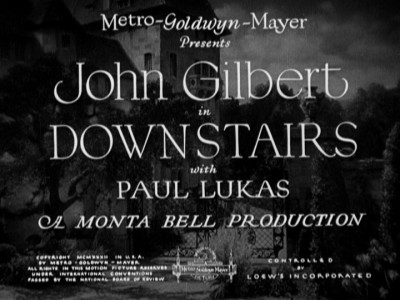
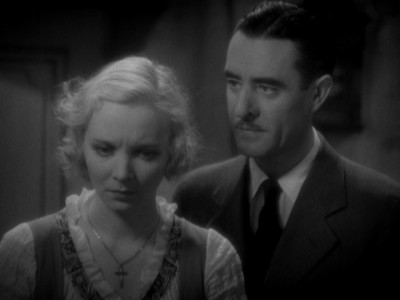
Mandalay (1934; 65 minutes)
The offbeat pencil-browed, widow's-peaked appeal of Forbidden Hollywood favorite Kay Francis dominates Mandalay, a slickly produced chunk of exotic hokum along the same lines as Greta Garbo's Mata Hari. In this Michael Curtiz-directed melodrama, Francis plays Tanya Borodoff, a Russian ex-pat who is left stranded in Rangoon after a gun-running deal brokered by her shifty boyfriend Tony Evans (Ricardo Cortez) goes afoul. The only hope left for Tanya lies with the man that Tony did business with, nightclub owner Nick (Warner Oland) - who transforms Tanya into sultry torch singer/prostitute "Spot White," the raven-haired centerpiece at his exotic hot spot. While Spot White becomes a sensation, the miserable Tanya finds a way out when threatened with deportation by the local police commissioner. Instead, she blackmails 10,000 rupees out of the man (with whom she once slept with) and takes the nearest steamboat to Mandalay. Traveling under the alias of Marjorie Lang, she meets an alcoholic doctor (Lyle Talbot) who is going to a plague-infested region of Burma as a last ditch effort to redeem himself. While Dr. Gregory Burton unloads his burdens on Marjorie/Tanya, falling for her in the process, the woman finds her escape isn't going so smoothly with the sudden reappearance of her sleazy ex-lover, Tony.
Although Mandalay turns into a conventional shipboard romance after Francis boards the steamboat to the title region, it still serves as an excellent sample of the escapist "women's pictures" that studios cranked out like sausages at the time. Despite the exotic trappings, Kay Francis' Tanya has an emotional stability and common decency that people can relate with, then and now. And the fact that she becomes a high class hooker? Just part of the complexity of the Pre-Code era. Warner Bros./First National lavished a lot of care on this particular vehicle, with a top-notch wardrobe for Francis from designer Orry-Kelly, luminous cinematography by the great Tony Gaudio, and smooth direction by Michael Curtiz. Perhaps it was put into place to disguise the standard he-done-me-wrong plot, but most of the time viewers will be too busy gawking at the wild imagery (Presumably nude Francis dropping her robe! A montage that cleverly uses the image of a spinning fan!) to notice. Another good Kay Francis flick.
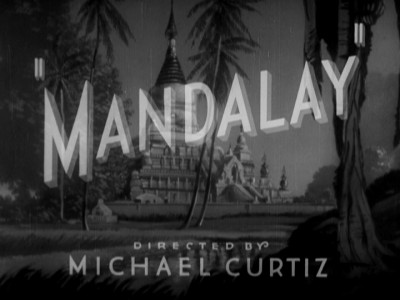
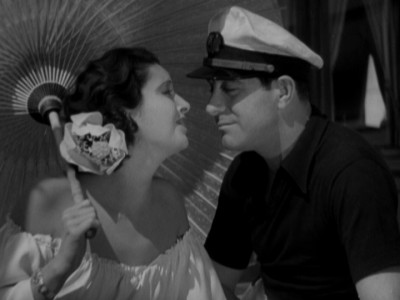
Massacre (1934; 70 minutes)
If anything, Massacre exists as fascinating evidence of an actor using his clout to advance personal causes - common practice today, extremely rare in the early 1930s. The actor in question is the commanding yet curiously forgotten Richard Barthelmess (Broken Blossoms), who had enough pull with Warner Bros. to star in a series of contemporary, socially conscious Pre-Code dramas. One of the last of them, 1934's Massacre, required Barthelmess to don Native gear and dark makeup as a full-blooded Sioux, Chief Joe Thuderhorse. Joe is a trick rider in a Chicago Wild West show, fully assimilated and yet exotic enough to attract the attentions of a high society dame (Claire Dodd). When he receives news that his father is dying, Joe takes his roadster out to the Dakotas and finds that the reservation is being exploited on all levels by a small band of greedy white men. The government-appointed overseer of the reservation, Elihu Quissenberry (Dudley Diggs) is found to be absconding with the possessions and property of men like Joe's father, dividing the spoils between himself, local undertaker Thomas Shanks (Sidney Toler, again) and a jittery doctor (Arthur Hohl). The situation reaches a boiling point when Shanks rapes Joe's sister, and Joe is put away in a sham trial for exacting revenge on Shanks. With the help of Lydia (Ann Dvorak), a beautiful Native woman, Joe escapes imprisonment and makes his way to Washington D.C. to meet up with the sympathetic Bureau of Indian Affairs director (Henry O'Neill) and ultimately bring justice to his tribe.
Awkwardly made at times but engrossing all the same, Massacre is another film that establishes Barthelmess as one of the definitive Pre-Code actors (although newbies to Barthelmess need to check out his amazing work in 1933's Heroes for Sale, included in the must-have Forbidden Hollywood, Vol. 3 set). Although it takes some adjusting to accept white actors Barthelmess and Dvorak as Natives, the film packs a lot of earnest yet non-preachy drama into its brisk 70 minutes (the location filming is good and most of the extras appear to be full-blooded Native, if that's any consolation). The stocky, intense Barthelmess plays Joe as a man who is able to straddle both Indian and White worlds effortlessly. The film does sport a regrettable stereotypical black sidekick (played by Clarence Muse), along with some credibility-defying scenes (Joe lassoing a man from a speeding car), but for the most part it's an earnest and memorable effort that deserves to get a second look.
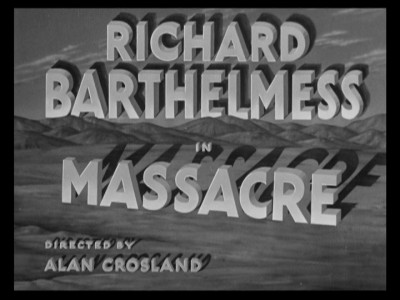
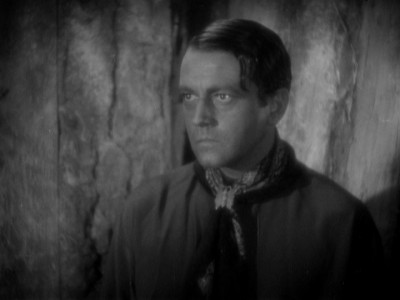
The DVDs:
The four discs of Forbidden Hollywood, Volume 6 come in a standard-width DVD case with no supplemental printed materials and basic info on the back cover. The menu designs on each disc are notably different from Volume 4 in the series (reviewed here), with individual designs based on the films' posters and lobby cards replacing Warner Archives' previous generic menus showing a backlot theater marquee. The discs themselves have a nicely redone, unified design as well.
Video:
Decent overall, but there are some slight problems with these unrestored transfers. The Wet Parade sports a comparatively nice looking picture with some dust and artifacts but an otherwise pleasantly balanced transfer. Downstairs is also mastered from a nicely preserved print, marred with a few instances of vertical white lines and small flecks and dust. Mandalay sports a pleasant picture, but the print used is markedly more aged with more artifacts and a few instances of flashing. The picture on Massacre also sports a fair share of dust and scratches, with one scene having the persistent jitter of warped or misaligned film.
Audio:
All four films sport their original mono soundtrack in all their unvarnished, occasionally hiss- and pop-ridden glory. Nothing that great to speak of sonically, but there weren't too many instances of sound flaws distracting from the viewing experience, either. No subtitles are provided on these discs.
Extras:
Lacking even basic scene-selection menus, the sole extra here is the interesting theatrical trailer on the Massacre disc. It's one of those previews that incorporates specially-filmed footage, here with actress Claire Dodd explaining the film's premise in a phony magazine interview setup.
Final Thoughts:
Four-disc, four-film set Forbidden Hollywood, Volume 6 continues the efforts of Warner Bros. exhuming their film library for delightful Pre-Code goodies. It's not too fancy in presentation, but filled with fascinating stuff all the same. Offbeat but ponderous anti-liquor tirade The Wet Parade is the only mediocrity in the set; the other three (Mandalay, Massacre, and the painfully overlooked Downstairs) are terrific additions to this growing series. Recommended.
Matt Hinrichs is a designer, artist, film critic and jack-of-all-trades in Phoenix, Arizona. Since 2000, he has been blogging at Scrubbles.net. 4 Color Cowboy is his repository of Western-kitsch imagery, while other films he's experienced are logged at Letterboxd. He also welcomes friends on Twitter @4colorcowboy.
|
| Popular Reviews |
| Sponsored Links |
|
|
| Sponsored Links |
|
|
| Release List | Reviews | Shop | Newsletter | Forum | DVD Giveaways | Blu-Ray | Advertise |
|
Copyright 2024 DVDTalk.com All Rights Reserved. Legal Info, Privacy Policy, Terms of Use,
Manage Preferences,
Your Privacy Choices | |||||||









